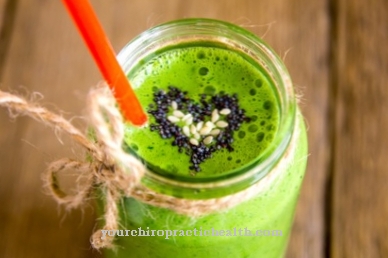The Paleo diet is a nutritional concept that is based on a book by the nutritionist Dr. Loren Cordain was established. In 2010 the first edition was published in the USA. The paleo principle has been enjoying steadily growing popularity since then and has meanwhile also become a major trend in Europe.
What does the Paleo principle mean?
The word "Paleo" is short for Palaeolithic, which means the Paleolithic Age. Hence this diet is often colloquially referred to as Stone Age Diet or Stone Age Diet designated. The principle is simple: humans should only consume those foods that were already consumed in the Stone Age.
Everything that humans as hunters and gatherers could procure is therefore allowed. According to the founder of the Paleo Diet, our bodies are genetically adapted to these foods. All products that came afterwards and were mainly processed by human hands and by industry are unsuitable for nutrition.
For orientation purposes, the date of the introduction of agriculture and animal husbandry about 10,000 years ago is given. From this point on, humans began to actively intervene in the production of their diet.
This is how you get started
Changing your diet radically from one day to the next is not only difficult but also confuses the body. For years he was trained to take in a lot of sugar and suddenly the new paleo diet comes out completely without any carbohydrates.
It is therefore recommended that you start slowly with the conversion. Instead of just eating paleo foods straight away, meals can exceptionally contain certain carbohydrates in the first week: root vegetables, sweet potatoes and plantains. They contain a lot less sugar and thus help you get used to it.
In the initial phase, the body begins to build new enzymes for the change in diet and its energy balance. Among other things, this leads to a loss of excess water. Drinking a lot is therefore important. Occasionally, there may be a cravings for sweets.
But here it is important to stay strong. It is clear that a strict implementation of the paleo diet will be difficult later in everyday life. But especially in the initial phase and in the first 30 days, you should live consistently. For the first time, the body can benefit from pure nutrition and improved wellbeing begins.
Which foods are allowed?
All foods that are unprocessed and thus in their real state are allowed in the Stone Age diet. Because they have retained their original state, they are still rich in nutrients. Food quality and the issue of sustainability should be taken into account when purchasing products. The following foods are recommended by the Paleo diet:
- vegetables
- fruit
- Herbs
- nuts
- Seeds
- flesh
- fish
- Eggs
- tea
- butter
- healthy fats and oils
The last point is controversial among Paleo supporters. In most cases, oils are industrially processed and should therefore not belong to the recommended foods by definition. Since oils and fats are essential components of many dishes, many people avoid the problem in the following way: they only consume oils that were produced from stone age plants. This means that olive, peanut and corn oil, for example, are not allowed.
In the case of fruit, daily consumption should be kept in mind. In addition to numerous vitamins, it contains a lot of fructose. To illustrate the whole thing briefly: half an apple contains a heaping teaspoon of sugar.
What about luxury foods?
Most of the luxury foods that are consumed today were only created after the introduction of arable farming and cattle breeding and are therefore classed as processed foods. Many of these foods contain what are known as anti-nutrients.
They are made by plants and animals in order not to be eaten by others. Heating up kills many of them when preparing food, but some of these substances still remain in the products. Examples are lectins in potatoes, phytic acid in cereals or trypsin inhibitors in legumes.
The following foods are therefore not part of a suitable paleo diet:
- Grain
- loaf
- Pasta
- legumes
- Dairy products (exception: butter)
- sugar
- Artificial sweeteners
- Processed vegetable fats
- Artificial additives
- Sugary drinks
- Sweets (for example chocolate)
- Artificially processed meat
In the case of beverages, such as coffee and alcohol, there is also controversy as to whether these are allowed. In any case, it is recommended to drastically reduce consumption and to pay attention to the exact ingredients of the drinks. Of course, all of these drinks are industrially processed, but contain different ingredients.
Beer and vodka have grain as the most important component, whereas sugar cane is the basic product in rum. Many of the ready-made meals available today and all varieties of fast food contain hidden sugars. These products should definitely be removed from the menu.
What are the risks of the paleo diet?
Opponents of the paleo diet like to emphasize the one-sided intake of nutrients. Because certain products are excluded from the outset, the body does not receive enough of the most diverse substances. In particular, the paleo principle is characterized by a very high-fat and meat-rich diet.
In turn, other substances such as carbohydrates are completely banned from the menu. Meat adds that amount of protein to the body, perhaps more than is healthy. In addition, the enormous meat consumption damages the climate balance.
There is also a risk that often occurs with diets: If you only switch to Paleo for a short time and then radically return to your old diet, you may have to struggle with a yo-yo effect.
How does Paleo work in the long term?
The long-term effect of Stone Age nutrition has so far been little researched. Most studies looked at a period of up to three months. The majority of the knowledge therefore comes from the users themselves.
Often these report a strange feeling in the first days and weeks. The body seems confused, but these symptoms soon subside. Instead, positive phenomena make themselves felt. The following side effects are often mentioned: calmer sleep, more energy in everyday life, increased well-being and better athletic performance.
Many diseases of civilization in today's society such as diabetes, multiple sclerosis, obesity and cardiovascular diseases are caused by an increased sugar intake. Many cancers are nourished by poor diet and the cancer cells love sugar.
The new type of diet stabilizes the blood sugar level, which also has an indirect effect on fewer cancer diseases. Also, better dental health and cleaner skin are worth mentioning. As with all new nutritional concepts, there are both proponents and critics.
Only a self-experiment will be able to show whether the Paleo principle has the desired positive effects. For those who are ready to orientate themselves towards the hunters and gatherers of the Stone Age, all that remains is: persevere!

















.jpg)



.jpg)

.jpg)




